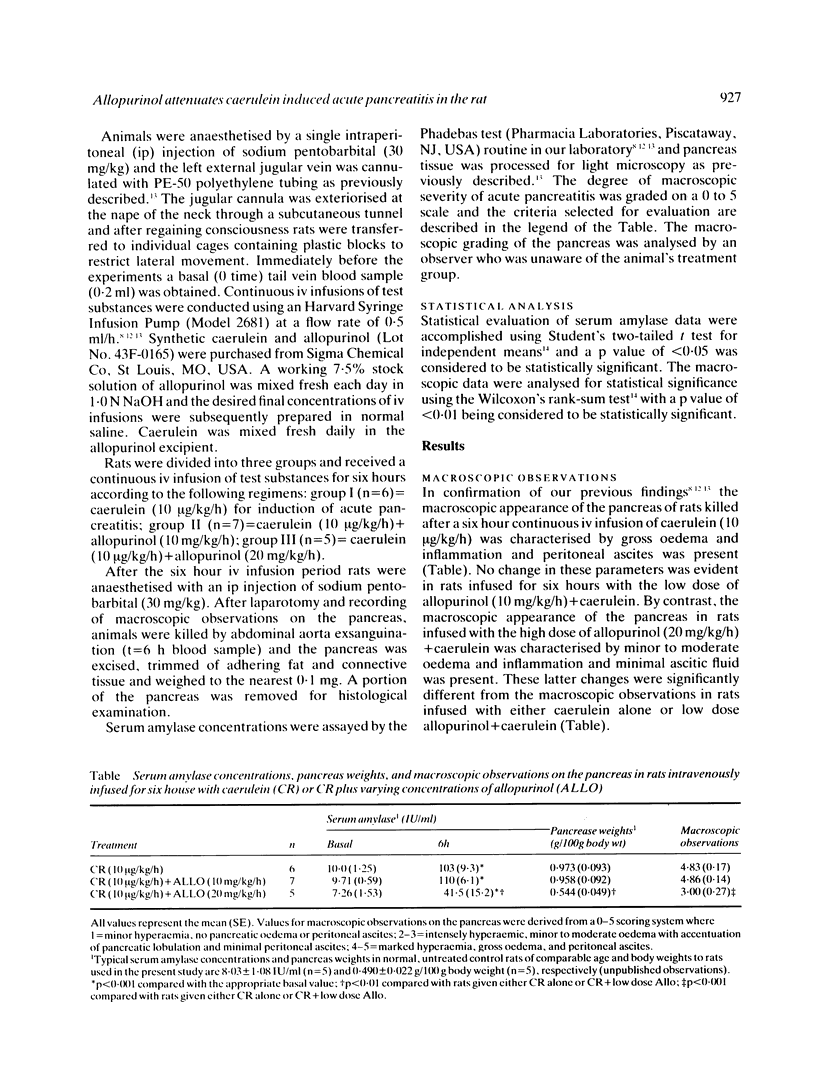Abstract
Oxygen derived free radicals have been implicated in the pathogenesis of acute pancreatitis in numerous animal models of the disease. The xanthine oxidase inhibitor allopurinol has been shown to attenuate pancreatic damage in canine and mouse models of acute pancreatitis presumably by preventing the generation of cytotoxic superoxide anions. We therefore examined whether allopurinol could attenuate pancreatic injury in conscious rats with caerulein induced acute pancreatitis. A continuous intravenous infusion of allopurinol (20 mg/kg/h) for six hours along with an acute pancreatitis producing dose of caerulein (10 micrograms/kg/h) reduced pancreas weights by approximately 45% and serum amylase concentrations by approximately 60% compared with rats intravenously infused with either caerulein alone or caerulein plus a lower dose (10 mg/kg/h) of allopurinol. We conclude that the generation of oxygen derived free radicals via pancreatic xanthine oxidase represents an early and perhaps pivotal mechanism in the pathogenesis of acute pancreatitis.
Full text
PDF



Selected References
These references are in PubMed. This may not be the complete list of references from this article.
- Adler G., Rohr G., Kern H. F. Alteration of membrane fusion as a cause of acute pancreatitis in the rat. Dig Dis Sci. 1982 Nov;27(11):993–1002. doi: 10.1007/BF01391745. [DOI] [PubMed] [Google Scholar]
- Guice K. S., Miller D. E., Oldham K. T., Townsend C. M., Jr, Thompson J. C. Superoxide dismutase and catalase: a possible role in established pancreatitis. Am J Surg. 1986 Jan;151(1):163–169. doi: 10.1016/0002-9610(86)90027-9. [DOI] [PubMed] [Google Scholar]
- Lampel M., Kern H. F. Acute interstitial pancreatitis in the rat induced by excessive doses of a pancreatic secretagogue. Virchows Arch A Pathol Anat Histol. 1977 Mar 11;373(2):97–117. doi: 10.1007/BF00432156. [DOI] [PubMed] [Google Scholar]
- McCord J. M., Roy R. S. The pathophysiology of superoxide: roles in inflammation and ischemia. Can J Physiol Pharmacol. 1982 Nov;60(11):1346–1352. doi: 10.1139/y82-201. [DOI] [PubMed] [Google Scholar]
- Niederau C., Ferrell L. D., Grendell J. H. Caerulein-induced acute necrotizing pancreatitis in mice: protective effects of proglumide, benzotript, and secretin. Gastroenterology. 1985 May;88(5 Pt 1):1192–1204. doi: 10.1016/s0016-5085(85)80079-2. [DOI] [PubMed] [Google Scholar]
- Parks D. A., Bulkley G. B., Granger D. N. Role of oxygen-derived free radicals in digestive tract diseases. Surgery. 1983 Sep;94(3):415–422. [PubMed] [Google Scholar]
- Proctor P. H., Reynolds E. S. Free radicals and disease in man. Physiol Chem Phys Med NMR. 1984;16(3):175–195. [PubMed] [Google Scholar]
- Renner I. G., Wisner J. R., Jr, Lavigne B. C. Partial restoration of pancreatic function by exogenous secretin in rats with ceruletide-induced acute pancreatitis. Dig Dis Sci. 1986 Mar;31(3):305–313. doi: 10.1007/BF01318123. [DOI] [PubMed] [Google Scholar]
- Renner I. G., Wisner J. R., Jr, Rinderknecht H. Protective effects of exogenous secretin on ceruletide-induced acute pancreatitis in the rat. J Clin Invest. 1983 Sep;72(3):1081–1092. doi: 10.1172/JCI111033. [DOI] [PMC free article] [PubMed] [Google Scholar]
- Rutledge P. L., Saluja A. K., Powers R. E., Steer M. L. Role of oxygen-derived free radicals in diet-induced hemorrhagic pancreatitis in mice. Gastroenterology. 1987 Jul;93(1):41–47. doi: 10.1016/0016-5085(87)90311-8. [DOI] [PubMed] [Google Scholar]
- Sanfey H., Bulkley G. B., Cameron J. L. The pathogenesis of acute pancreatitis. The source and role of oxygen-derived free radicals in three different experimental models. Ann Surg. 1985 May;201(5):633–639. doi: 10.1097/00000658-198505000-00013. [DOI] [PMC free article] [PubMed] [Google Scholar]
- Sanfey H., Bulkley G. B., Cameron J. L. The role of oxygen-derived free radicals in the pathogenesis of acute pancreatitis. Ann Surg. 1984 Oct;200(4):405–413. doi: 10.1097/00000658-198410000-00003. [DOI] [PMC free article] [PubMed] [Google Scholar]
- Sanfey H., Sarr M. G., Bulkley G. B., Cameron J. L. Oxygen-derived free radicals and acute pancreatitis: a review. Acta Physiol Scand Suppl. 1986;548:109–118. [PubMed] [Google Scholar]
- Sarr M. G., Bulkley G. B., Cameron J. L. Temporal efficacy of allopurinol during the induction of pancreatitis in the ex vivo perfused canine pancreas. Surgery. 1987 Mar;101(3):342–346. [PubMed] [Google Scholar]
- Sarr M. G., Bulkley G. B., Cameron J. L. The role of leukocytes in the production of oxygen-derived free radicals in acute experimental pancreatitis. Surgery. 1987 Mar;101(3):292–296. [PubMed] [Google Scholar]
- Slater T. F. Free-radical mechanisms in tissue injury. Biochem J. 1984 Aug 15;222(1):1–15. doi: 10.1042/bj2220001. [DOI] [PMC free article] [PubMed] [Google Scholar]
- Steer M. L., Meldolesi J., Figarella C. Pancreatitis. The role of lysosomes. Dig Dis Sci. 1984 Oct;29(10):934–938. doi: 10.1007/BF01312483. [DOI] [PubMed] [Google Scholar]
- Watanabe O., Baccino F. M., Steer M. L., Meldolesi J. Supramaximal caerulein stimulation and ultrastructure of rat pancreatic acinar cell: early morphological changes during development of experimental pancreatitis. Am J Physiol. 1984 Apr;246(4 Pt 1):G457–G467. doi: 10.1152/ajpgi.1984.246.4.G457. [DOI] [PubMed] [Google Scholar]
- Wisner J. R., Jr, Renner I. G., Grendell J. H., Niederau C., Ferrell L. D. Gabexate mesilate (FOY) protects against ceruletide-induced acute pancreatitis in the rat. Pancreas. 1987;2(2):181–186. doi: 10.1097/00006676-198703000-00010. [DOI] [PubMed] [Google Scholar]


